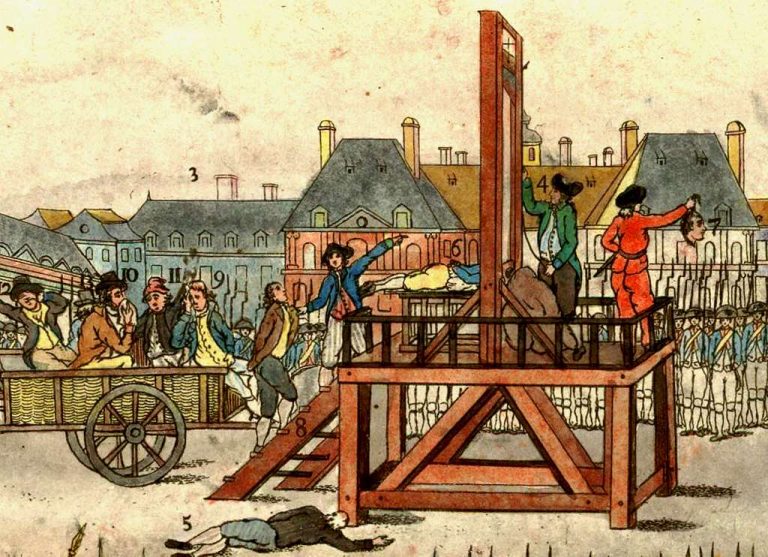
“He will be taken in a tumbrel by the executioner who will attach before and behind him a sign on which will be written, in large letters impious one; and there, being on his knees, will confess his crimes…; this done, will have the tongue cut out and will then be taken in the said tumbrel to the public marketplace of this city to have his head cut off on a scaffold; his body and his head will then be thrown on a pyre to be destroyed, burnt, reduced to ashes and these thrown to the wind.”
Paris, France. Jean-François Lefebvre de la Barre, a young French nobleman, was tortured and beheaded before his body was burnt on a pyre along with Voltaire‘s Philosophical Dictionary nailed to his torso. La Barre is said to have been executed for not saluting a Catholic religious procession, along with other charges of a similar nature were laid against him.
In France, Lefebvre de la Barre is widely regarded a symbol of the victims of Roman Catholic religious intolerance. A statue to de la Barre stands near the Basilica of the Sacred Heart of Jesus of Paris at the summit of the butte Montmartre (itself named from the Temple of Mars), the highest point in Paris and an 18th arrondissement street nearby the Sacré-Cœur is also named after Lefebvre de la Barre.

On 9 August 1765, the wooden crucifix on a bridge in Abbeville was vandalized. Catholicism was then the state religion of France and the religion of the vast majority of the French public, especially in the devout town of Abbeville, where this act caused widespread shock and anger.
Voltaire says the Catholic bishop of Amiens roused the furor of the faithful and asked churchgoers to reveal all they could about the case to the civilian judges, under pain of excommunication.
Among other things, it came out that three young men, Jean-François de la Barre and his friends, had not removed their hats when a Corpus Christi procession went by. This incident is often cited as the main basis for the charges. But numerous other blasphemies were alleged as well, including defecation on another crucifix, singing impious songs, and spitting on religious images.
During the inquiry, la Barre‘s bedroom was searched and among his mainly pornographic prohibited books, Voltaire‘s Philosophical Dictionary was found – providing a pretext to blame the Philosophes for the young men’s misbehavior.
On 20 February 1766, local judges handed down the sentence:
“Regarding Jean-Francois Lefebvre, chevalier de La Barre, we declare him convicted of having taught to sing and sung impious, execrable and blasphemous songs against God; of having profaned the sign of the cross in making blessings accompanied by foul words which modesty does not permit repeating; of having knowingly refused the signs of respect to the Holy Sacrament carried in procession by the priory of Saint-Pierre; of having shown these signs of adoration to foul and abominable books that he had in his room; of having profaned the mystery of the consecration of wine, having mocked it, in pronouncing the impure terms mentioned in the trial record over a glass of wine which he held in his hand and then drunken the wine; of having finally proposed to Petignat, who was serving mass with him, to bless the cruets while pronouncing the impure words mentioned in the trial record.”
“In reparation of which, we condemn him to make honorable amend, in smock, head bare and a rope around his neck, holding in his hands a burning candle of two pounds before the principal door of the royal church… of Saint-Wulfram, where he will be taken in a tumbrel by the executioner who will attach before and behind him a sign on which will be written, in large letters impious one; and there, being on his knees, will confess his crimes…; this done, will have the tongue cut out and will then be taken in the said tumbrel to the public marketplace of this city to have his head cut off on a scaffold; his body and his head will then be thrown on a pyre to be destroyed, burnt, reduced to ashes and these thrown to the wind.”
“We order that before the execution of the said Lefebvre de La Barre the ordinary and the extraordinary question [that is, torture] will be applied to have from his mouth the truth of several facts of the trial and revelation about his accomplices… We order that the Philosophical Dictionary… be thrown by the executioner on the same pyre as the body of the said Lefebvre de La Barre.
On 1 July, la Barre was tortured early in the morning. Though he appears to have been with others when he committed some of the lesser acts named in the sentence, he refused to name any even under torture. Later the same day he was beheaded and his body burned, the ashes thrown in the Somme River. Voltaire‘s work was burned along with la Barre’s body.
François-Jean de la Barre: French Icon for Religious Intolerance (July 3, 2018)